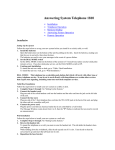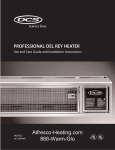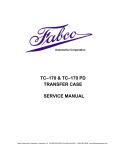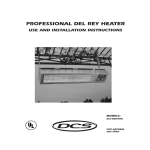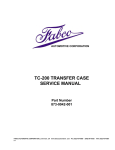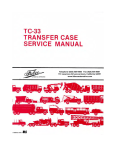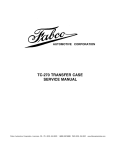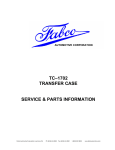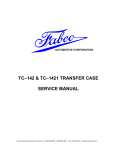Download TC-65, TC-80, TC-110 & PTO-110 Service Manual
Transcript
Telephone (925) 454-9500 Fax (925) 454-9501 151 Lawrence, Livermore, CA 94551 www.fabcoautomotive.com Fabco Automotive Corporation Service and Parts Manual Models TC-65, TC-80, TC-110 and PTO-110 TABLE OF CONTENTS I. Operating Instructions A. Front Drive B. Underdrive (TC-65 Only) C. Power Take-Off 3 3 3 II. Lubrication A. B. C. D. E. F. Transfer Case Oil Change Draining Oil Refilling Oil Inspection Operating Temperature Shift Cylinder Inspection 5 5 5 5 5 5 VII. Torque Specifications 24 VIII. Parts Manual 25 PARTS MANUAL STARTS ON PAGE 25 Ill. Transfer Case Removal and Installation A. Removal from Vehicle B. Installation into Vehicle 6 6 IV. Transfer Case Disassembly A. B. C. D. E. F. G. H. I. General Precautions for Disassembly Preparation for Disassembly Shift Cylinder Disassembly PTO and Declutch Disassembly Splitting the Main Housing Input Shaft Disassembly Intermediate Shaft Disassembly Output Shaft Disassembly Oil Pump Disassembly 7 7 7 8 9 9 10 10 11 V. Cleaning and Inspection A. Choice of Cleaning Methods B. Drying and Corrosion Inhibition C. Inspection 12 12 12 VI. Transfer Case Assembly A. B. C. D. E. F. G. General Precautions for Reassembly Input Shaft Assembly Intermediate Shaft Assembly Output Shaft Assembly Main Housing Assembly Declutch and PTO Assembly Shift Cylinder Assembly and Adjustment H. Oil Pump Assembly I. Final Assembly 13 14 15 16 17 20 22 23 23 625 403A Copyright © 1984 by Fabco Automotive, Livermore, California 94551 TC-65, TC-80, TC-110, TRANSFER CASE PTO-110, SPLIT-SHAFT PTO TC-65 TC-80 TC-110 TC-OPTIONS PTO-110 I. OPERATING INSTRUCTIONS Front Drive Power Take-Off When traveling through sand, loose dirt, mud, snow or ice, or when ascending grades where the rear wheels might spin, shift to front wheel drive for better traction. Shift before the truck is in trouble. Engagement and disengagement of the front axle can best be made while the engine is pulling lightly. It can be shifted at any speed provided the rear wheels are not spinning. An indicator switch is actuated when the shifter shaft is in the engaged position. If the transfer case is equipped with a power take-off or a PTO mounted hydraulic pump, it can be operated while the vehicle is moving or stationary. To engage vehicles fitted with an automatic transmission, put transmission and transfer case in gear, apply the brakes and shift the PTO or hydraulic pump into the engaged position, while the engine is idling. After the PTO has been engaged, shift the transmission and transfer case to the desired gear. An indicator switch is actuated when the shifter shaft is in the engaged position. Underdrive (TC-65 only) To disengage the PTO or hydraulic pump, shift the transmission to neutral (manual or automatic), allow the machinery to come to rest, then shift the control to disengage. When slow, positive pulling power is desired, shift to underdrive. Underdrive may be used to obtain a convenient combination with third or direct for climbing some grades. The transfer case should be shifted between high and low range only when the truck is stopped. —3— II. LUBRICATION Recommended Lubricants On Highway Vehicles Type Grade Temperature MIL-L-2104 Heavy-Duty Engine Oil SAE 50 SAE 30 Above + 10°F. Below + 10°F. Mineral Gear Oil SAE 90 SAE 80 Above + 10°F. Below + 10°F. MIL-L-2105 E.P. Oil, except Sulfur-chlorine-lead type. SAE 90 SAE 80 Above + 10°F. Below + 10°F. Heavy-duty engine oil. Make sure to specify heavy-duty type meeting MIL-L-2104 specifications. Mineral gear oil inhibited against corrosion, oxidation and foam. Off Highway & Mining Equipment Type Grade Temperature MIL-L-2104 Heavy-Duty Engine Oil SAE 50 SAE 30 Above + 10°F. Below + 10°F. Special Recommendation—For extreme cold weather where temperature is consistently below 0°F: MIL-L-2104 Heavy-Duty Engine Oil SAE 20W —4— Below 0°F. II. LUBRICATION NOTE: Oil Change and Inspection Recommendations: The oil change and inspection periods described below are based on the average use and operating conditions the transfer case may encounter. It is recommended that the individual owner make a periodic lab analysis of the lubricant to determine contamination based on the individual’s own operating conditions. With this data the individual owner can better determine their own oil change and inspection periods. A. Transfer Case Oil Change D. Inspection Transfer case lubricant should be changed on all new transfer cases after the first 3,000 to 5,000 miles (on-highway), or first 40 hours (off-highway); thereafter, oil changes should be done at the following intervals: Gear oil level is to be maintained at the level of the fill plug at all times. Check at the following intervals: On-Off Highway Service......... 10,000 - 15,000 miles E. Operating Temperature Highway Service Off-Highway Service Off-Highway Service (Logging, dirt moving, mining and associated operations).............. 500-750 hours, as indicated by operation and contamination of lubricant. B. Draining Oil Draining is best accomplished after the vehicle has been operated briefly, allowing the oil to become warm and flow freely. Remove both drain and fill plugs and allow housing to empty completely. After transfer case has been drained and before it is refilled, the case should be thoroughly flushed with clean flushing oil or kerosene. 1,000 miles 40 hours The operating temperature of the transfer case should never exceed 250°F (120°C). Extensive operation at temperatures exceeding 250°F will result in rapid breakdown of the oil and shorten the transfer case life. F. Shift Cylinder Inspection With every oil change the air shift cylinder lines and valves should be inspected for leaks and possible malfunctioning. Low pressure conditions can cause partial clutch tooth engagement which may result in “gear jumping” and premature wear. C. Refilling Oil If the transfer case has been removed from the vehicle for service, it is best to refill the oil after the transfer case has been reinstalled into the vehicle. Clean and replace drain plug and fill the transfer case with appropriate gear oil with the vehicle on level ground (see recommended lubricant chart). Fill transfer case to the level of the fill plug, metering approximately 10½ quarts of gear oil into the transfer case. The exact amount may differ depending upon the inclination of the transfer case. Always fill to the level of the fill plug. Replace fill plug and examine transfer case for leaks around plugs and gasket sealed areas. Do not overfill the transfer case. —5— Ill. TRANSFER CASE REMOVAL AND INSTALLATION B. Installation into Vehicle A. Removal from Vehicle 2. Disconnect indicator light wires. 1. Place transfer case on transmission jack and position jack and transfer case under the vehicle. 3. Disconnect the air shift lines. Be sure to tag the lines for future identification. 2. Raise transmission jack and position transfer case. 4. Disconnect the speedometer cable if it is so equipped. 3. Connect transfer case mountings. Since mountings vary, consult the vehicle service manual. 5. Disconnect drivelines at flanges. 4. Connect drivelines. 6. If the transfer case is equipped with a PTO mounted hydraulic pump, remove the four mounting bolts, slide the pump out of the transfer case and secure pump to the frame and out of the way. 5. Connect shift cylinder air lines to air cylinders. 1. Remove fill and drain plugs and drain lubricant. 6. Install hydraulic pump to transfer case if it is not already. 7. Connect indicator light lead wires to terminals. NOTE: If it is desired, the hydraulic lines can be disconnected and the pump can be detached after the transfer case has been removed from the vehicle. 8. Fill transfer case housing with appropriate lubricant to the correct level and install fill plug. (Refer to lubrication, Section Il.) 9. Road test the vehicle by driving slowly with no load for the first few moments, then test at a higher speed listening for any problems. 7. Position a transmission jack of suitable capacity beneath the transfer case (800 lb. transfer case). Be sure that the transfer case is seated safely on the jack. 10. Check transfer case for leaks around gaskets and seals. 8. Disconnect transfer case mountings at rubber insulators. Since mountings vary, consult the vehicle service manual. 9. Check to ensure that all mountings and connections to the transfer case have been disconnected. Lower the transfer case to the floor and remove from under the vehicle. It may be necessary to jack the vehicle up to allow room to remove the transfer case. —6— IV. TRANSFER CASE DISASSEMBLY A. General Precautions for Disassembly The PTO-110 is installed reversed, so TC-110 front is the same as PTO-110 back, and shaft rotations are reversed. The PTO-110 oil pump is assembled to pump in reverse rotation, so transfer case and Power Take Off oil pumps are NOT interchangeable. IMPORTANT: Read this section before starting the disassembly procedures. It is assumed in the disassembly instructions that the lubricant has been drained from the transfer case and the transfer case has been removed from the chassis. Follow each procedure closely in each section, making use of both tests and pictures. Refer to the exploded views located in Section VIII as an aid in disassembly. 1. The outside of the unit should be cleaned before starting the disassembly. If steam cleaning, ensure that breather and air fittings are covered to prevent water from entering assembly. B. Preparation for Disassembly 1. After removing the transfer case from the vehicle, remove any mounting brackets still attached to the transfer case. 2. Remove oil lines if so equipped. C. Shift Cylinder Disassembly (High-Neutral-Underdrive) 1. Remove four bolts from the shift cylinder cap and remove cap from shift cylinder. Discard Oring from cylinder cap, if replacement is necessary. 2. Cleanliness—Provide a clean place to work. It is important that no dirt or foreign material enters the unit during repairs. 2. Remove shift cylinder tube from the shift cylinder adapter tube located in the housing, exposing piston. 3. Position the transfer case in a stand suitable to support the transfer case. A specially fabricated stand that can rotate the case is extremely useful. 3. Disassemble shift piston from the shift shaft and discard O-ring and felt wiper, if replacement is necessary. 4. Assemblies—When disassembling the various assemblies, lay all parts on a clean bench in the same sequence as removed. This procedure will simplify reassembly and reduce the possibility of lost parts. 4. Remove shift shaft spring and plastic stop ring from the shift shaft or from the shift cylinder adapter tube located in the housing. 5. Remove shift cylinder adapter tube from housing. Discard O-rings from the adapter, if replacement is necessary. 5. Bearings—Carefully wash and relubricate all bearings as removed and protectively wrap until ready for use. Remove bearings with pullers designed for this purpose, or in a manner which will not damage those bearings that will be reused. 6. Snap Rings—Remove snap rings with pliers or special tools designed for this purpose. Rings removed in this manner can be reused. 7. When necessary to apply a force to remove a part, use of a puller or press would be preferred. However, sometimes it may be necessary to use a soft hammer or mallet. 8. The PTO-110, a variant configuration of the TC110, is used for a Split-Shaft Power Take Off. Refer to the TC-110 instructions for assembly and disassembly. Minor differences are noted in the TC-110 text. —7— IV. TRANSFER CASE DISASSEMBLY D. PTO and Declutch Disassembly The declutch assembly and PTO are essentially identical. Hereafter, reference will be made to the declutch only. For cases equipped with PTO, use the instructions for declutch disassembly, inspection and reassembly exactly as given. 1. Remove eight capscrews holding declutch carrier to declutch housing. 2. Tap carrier to loosen and withdraw carrier and output shaft assembly (see fig. 1). 3. Unscrew indicator light switch from declutch housing and remove spacer washers. Remove switch actuator pin from inside declutch housing using a magnet or turn upside down and dump it out. Fig. 1 4. Remove four capscrews from declutch cover plate and remove cover plate. 5. Cut the lockwires and remove the shift fork clamping screws (see fig. 2). 6. Remove four long capscrews from shift cylinder and lift off cylinder cap. 7. Withdraw shift piston and shift shaft as a unit. 8. Remove shift cylinder adapter tube and stop ring, discarding O-rings. 9. Remove nut from shift shaft and lift off the piston and ‘spring, discarding O-rings and felt wiper. NOTE: There are two plastic stop rings and no spring in the PTO-110 cylinders. Fig. 2 10. Withdraw shift fork and clutch collar (see fig. 3). 11. Remove six capscrews holding declutch housing to main case. Remove the declutch housing by tapping it with a soft hammer loosening it from the main case. Remove shims and retain with housing for later use at assembly. 12. Remove companion flange lock nut and washer from carrier and output shaft assembly, discarding nut. Use a new nut for reassembly. Slide companion flange off output shaft. 13. To press output shaft from declutch carrier and clutch gear, press against threaded end of shaft while supporting by the clutch gear. 14. Remove output seal, bearings, and end play spacer from declutch carrier, discarding seal. Remove bearing cups from the declutch carrier, only if they are to be replaced. Fig. 3 —8— IV. TRANSFER CASE DISASSEMBLY E. Splitting the Main Housing 1. Remove the declutch and PTO assembly (if so equipped) from the transfer case (see part D, this section). 2. Remove the top input flange locknut and washer and remove flange from shaft. Discard locknut and replace with a new locknut at assembly. Remove bolts from seal carrier and remove seal carrier from case. Remove seal from carrier if replacement is necessary. 3. If the transfer case is a two-speed (TC-659, remove the speedometer driven gear and adapter from the speedometer gear and seal carrier. The lower rear output flange may now be removed after the locknut and washer have been removed. Discard locknut and replace with a new locknut at assembly. Remove bolts from speedometer gear and seal carrier (TC-65) or seal carrier (TC-80 and TC-110) and remove carrier. Remove seal from carrier if replacement is necessary. Fig. 4 3. Remove locknut and washer from rear of shaft and slide blanking sleeve from the shaft. Discard locknut and replace with a new locknut at assembly. The direct drive gear and remaining parts can now be disassembled. 4. Remove bolts from the intermediate shaft rear cap and remove cap. Remove shims and retain with cap for later use at assembly. Remove oil pump from cap for further disassembly (see part I, this section). 5. If the transfer case is not equipped with a PTO, remove the bolts from the input shaft rear cap and remove the cap. Remove shims and retain with cap for later use at assembly. 6. The case should now be supported by the front half and be positioned so that the rear half of the case is facing upwards. Mark the housing halves as a set as these must be reassembled together. Remove all the bolts that hold the housing halves together and lift off the rear housing half (see fig. 4). The three shafts can now be lifted out of the front half of the case. NOTE: The stationary shifter shafts, or neutral gear range shifter shafts will have to be removed with the input and output shafts. F. Input Shaft Disassembly TC-65: 1. Slide underdrive gear, needle bearings and needle bearing race from front of shaft. If necessary, lift underdrive gear from needle bearing race. Collect the needle bearings and spacer ring and place into a container. 2. Side clutch collar and clutch gear from shaft. —9— NOTE: The standard case has a splined sleeve on the rear of the input shaft called a blanking sleeve. On cases with PTO or direct pump drive this sleeve is replaced by a gear (identical to the front output shaft declutch gear) to furnish a drive for the PTO. Other than having external teeth to drive the PTO, the declutch gear is identical to and has the same function as the blanking sleeve, that of carrying the rear bearing cone. Hereafter, to simplify technology, the part will be referred to as the blanking sleeve, even if it is actually a declutch gear. The front output part will be referred to as a declutch gear, since a blanking sleeve is never used in this position. 4. If necessary, remove the roller bearing cone from the blanking sleeve. TC-80: 1. Slide the spacing sleeve, clutch gear and clutch collar from the shaft. 2. Remove locknut and washer from rear of shaft and slide blanking sleeve from the shaft. Discard locknut and replace with a new locknut at assembly. The direct drive gear and remaining parts can now be disassembled. 3. If necessary, remove the roller bearing cone from the blanking sleeve. IV. TRANSFER CASE DISASSEMBLY F. Input Shaft Disassembly (cont.) TC-110: TC-110: HEATING IS NOT REQUIRED FOR REMOVAL OF THE INTERMEDIATE SHAFT GEAR. 1. Slide the spacer rings and clutch collar from the front of the shaft. 2. Remove the locknut and washer from the rear of shaft and, using a puller in the groove provided, remove the blanking sleeve from shaft. Discard locknut and replace with a new locknut at assembly. The direct drive gear and remaining parts can now be disassembled. 1. Press shaft from the gear and rear roller bearing cone. 2. Press front bearing from shaft if necessary. H. Output Shaft Disassembly TC-65 & TC-80: 3. If inner race and inner thrust washer are not worn or damaged, do not remove. If replacement of either is required, the inner race must be ground, hacksawed or torched off, taking care not to damage the shaft itself. The inner race cannot be removed without destroying it. 1. Press shaft from the direct drive gear by placing the front of the gear on a metal tube and apply pressure to the rear of the output shaft. Remove the roller bearing, bearing adapter tube, direct gear and related parts from the shaft. 4. If necessary, remove the roller bearing cone from the blanking sleeve. 2. Press the roller bearing cone from the bearing adapter tube if necessary. 3. Remove locknut and washer from the declutch gear and remove declutch gear. Discard locknut and replace with a new locknut at assembly. Slide spacer sleeve from shaft. If necessary, press roller bearing cone from the hub of the declutch gear. G. Intermediate Shaft Disassembly NOTE: Intermediate shaft gears are a tight press fit on the shaft. Disassembly is not advised unless there is damage to shaft or gears and replacement is necessary. TC-65: TC-110 1. Heat the gears evenly and carefully to 200°F (93° C) using temperature marker to determine. 2. Press the underdrive gear off the shaft first and remove the key. This will allow the direct drive gear and spacer to be pressed off. IMPORTANT: Do not attempt to press both gears off at one time. Damage to the shaft, gears and the press may result. TC-80: 1. Heat the direct drive gear (as for the TC-65, above) and press off the shaft. —10— 1. Slide direct drive gear, spacers and remaining parts from shaft. 2. Remove the locknut and washer from the declutch gear and remove declutch gear. Discard the locknut and replace with a new locknut at assembly. Slide spacer ring from rear of shaft. If necessary, press roller bearing cone from the hub of the declutch gear. 3. If inner race and inner thrust washer are not worn or damaged, do not remove. If replacement of either is required, the inner race must be ground, hacksawed or torched off, taking care not to damage the shaft itself. The inner race cannot be removed without destroying it. IV. TRANSFER CASE DISASSEMBLY I. Oil Pump Disassembly 1. Place pump in a vise, shaft facing up, so that one jaw grips across two ports. Use care to avoid distorting pump housing by excessive tightening of vise. 2. Remove any burrs on shaft drive tang. 3. Remove housing plug with a suitable spanner wrench. 4. Remove from vise and punch match marks (or paint dab) on cover and body for reassembly. 5. Remove capscrews, cover, idler, and rotor from housing. 6. Check pump housing, rotor, idler gear, idler pin and crescent for wear, chipped or broken teeth. 7. Housing bore and rotor O.D. may be checked for wear by positioning rotor in the housing and check for clearance in the bearing. The shaft must turn freely without any detectable side play. Any side play will require replacement of housing, rotor or both. If both housing and rotor require replacing, it is economically advisable to replace the pump. NOTE: The PTO-110 pump has the cover reversed to allow flow in the opposite rotation direction. Note the position of the notch in the cover prior to disassembly. —11— V. CLEANING AND INSPECTION A. Choice of Cleaning Methods C. Inspection 1. Steam may be used for external cleaning of completely assembled units. Care must be taken to ensure that water is kept out of the assembly by tightly closing breather caps and other openings. 2. Rough parts such as the housing, which are too large to conveniently clean with solvents, may be immersed in a hot solution tank containing a mild alkaline solution. Parts cleaned in hot solution tanks must be rinsed thoroughly to prevent damage by traces of alkaline material. 3. Parts with ground or polished surfaces, such as bearings, gears, and shafts, should be cleaned with emulsion cleaners or petroleum solvents. Alkaline hot solution tanks may damage the machined surfaces and such cleaning methods should be avoided. Prior to reassembly, parts which are to be reused must be carefully inspected for signs of wear or damage. Replacement of such parts can prevent costly downtime at a future date. All bearing surfaces, including roller bearing cups and cones, should be examined for pitting, wear, or overheating. Gears also may show pits, as well as scoring and broken teeth. Shafts may be nicked or marred, or may have damaged threads. Parts which show any signs of damage should be repaired or replaced. Check all shift forks and slots in sliding clutches for extreme wear or discoloration from heat. Check engaging teeth of sliding clutches for partial engagement pattern. B. Drying and Corrosion Inhibition Soft clean shop towels should be used to dry parts after cleaning. Compressed air may be used to clean inaccessible areas of large parts such as the housing. Bearings should not be spun dry with compressed air, as the lack of lubrication may cause damage to the mating surfaces. Dried parts should be immediately coated with a light oil or corrosion inhibitor to prevent corrosion damage. Parts which are to be stored should also be wrapped in heavy waxed paper. —12— VI. TRANSFER CASE ASSEMBLY B. Input Shaft Assembly TC-65 & TC-80: A. General Precautions for Reassembly IMPORTANT: Read this section before starting reassembly procedure. Make sure that the interior of the transfer case is clean. It is important that dirt be kept out of transfer case during reassembly. Use certain precautions, as listed below, during reassembly. 1. Gaskets — Clean all gasket surfaces of past gasket material. Use new gaskets throughout the transfer case as it is being rebuilt. 2. Bolts — To prevent oil leakage, use Permatex Form-A-Gasket #2 pliable setting sealant or equal on all threads. See torque specifications for recommended torque, Section VII. 3. Assembly — Refer to the exploded views in the parts manual (Section VIII) as a guide to reassembly. Fig. 5—TC-65 Input Shaft Assembly with Blanking Sleeve 4. Initial Lubrication — Coat all thrust washers, splines and seals with lubriplate during installation to provide initial lubrication, preventing scoring and galling. 5. Bearings — Press or drive bearing races by applying force to inner race or outer race, whichever is being installed. 6. Universal Joint Companion Flanges — Pull the companion flanges tightly into place with the locknuts (old locknuts may be used for pulling, then replaced with new); tighten to proper torque. Failure to pull the flange tightly into place will not seat the bearings properly, causing erroneous end play readings and possible damage to bearings, shafts, and gears. Fig. 6—TC-65 Input Shaft Assembly with PTO Gear 7. Inspect all spacer washers and rings for wear. The width or thickness of each spacer washer or ring has been noted in the assembly procedures and each spacer should be measured with a micrometer for proper size. Worn spacers should be replaced. 8. The clutch collar shift fork slot is offset, which is indicated in Fig. 5. The long side can be determined by examining the collar for the external short extended hub. This short hub, referred to in the assembly instructions, must always face the mating gear clutch teeth, whether in the declutch housing, PTO housing or main case. Fig. 7—TC-80 Input Shaft Assembly with PTO Gear —13— VI. TRANSFER CASE ASSEMBLY rear of the shaft. Slide the clutch collar onto the teeth of the clutch gear. The side of the collar with the short hub is to face the rear of the shaft (see fig. 5) B. Input Shaft Assembly (continued) TC-65 & TC-80: (See Fig. 5, 6 and 7) 1. Place input shaft thrust washer (.148 thick) on bench. Liberally grease inside diameter of direct drive and outside diameter of needle bearing race. Place front of direct drive gear (side of gear with clutch teeth) on thrust washer. Place needle bearing race inside the gear with the bearing race lock pin facing the rear of the gear (or up). Grease needle bearings and install a row of needle bearings between gear and race. NOTE: Install 62 needle bearings only in each row. One extra needle can be packed into each row, but this makes the rollers too tight, invariably causing rubbing, heating and eventual failure of the bearing pack, gear and shaft. 6. Place direct drive gear assembly (including gear spacer ring and thrust washer) over the shaft aligning inner race lock pin with elongated groove in shaft and against the clutch gear. The clutch teeth of the gear must face the front of the shaft. 7. Press the bearing cone over the blanking sleeve hub and slide the sleeve over the shaft splines and secure with the washer and locknut. Tighten nut to correct torque. Check thrust washer clearance as above, .015-.020. 8. Set the shaft aside for installation into the front half of the main case. Refer to Part E, page 16, for this assembly. Remove the flange from the shaft that was used to support the shaft during assembly, making sure to retain underdrive gear, needles and inner race in position. Install a spacer ring, tap the needle bearings and spacer ring against the shoulder of the race with a punch and install next row of bearings. 2. Place gear spacer ring (3/8" thick) on top of gear assembly with chamfered inside diameter facing inside of gear. 3. Two-speed case only (TC-65): Grease inside diameter of underdrive gear and outside diameter of needle bearing race. Place needle bearing race on the bench with the flange facing down. Place underdrive gear onto the race with the clutch teeth facing up. Grease needle bearings and install a row of needle bearings between gear and race. NOTE: Install 62 needle bearings only in each row. One extra needle can be packed into each row, but this makes the rollers too tight, invariably causing rubbing, heating and eventual failure of the bearing pack, gear and shaft. Install a spacer ring, tap the needle bearings and spacer ring against the shoulder of the race with a punch and install next row of bearings. Fig. 8 4. Two-speed case only (TC-65): Install the front side of the input shaft (short journal) through the underdrive gear assembly. (The flange of the underdrive gear inner bearing race is to face the front of the shaft and the clutch teeth of the gear are to face the center of the shaft). Align the inner race lock pin with the elongated groove in the journal and slide gear on all the way. With inner race pressed tightly against inner thrust washer, check with a feeler gauge for .015-.020 clearance between gear hub and thrust washer. 5. For ease in assembly, use a companion flange from the transfer case as a stand for the shaft. Slide the flange onto the front of the shaft and stand the shaft upright. Slide the clutch gear onto the raised teeth of the shaft. The jump lock portion of the teeth (see fig. 8) are to face the Fig. 9—TC-110 Input Shaft Assembly —14— VI. TRANSFER CASE ASSEMBLY B. Input Shaft Assembly (continued) TC-110: (see fig. 9) 1. If the inner thrust washer and needle bearing race have been removed from the rear of the input shaft, place the thrust washer (.148" thick) over the shaft and against the raised teeth of the gear. Oil groove side of washer to face outwards and toward where the direct drive gear will be placed. Heat the inner race in an oven to about 200-250°, drop over shaft and tap down to the inner thrust washer with a suitable driver (the roller bearing inner race must be snug against the inner thrust washer). 2. Slide two roller bearing assemblies and spacer ring over the roller bearing inner race located at the rear of the shaft. Grease the roller bearing assemblies and the inner diameter of the direct drive gear. Slide the gear over the rear of the shaft. Place the gear spacer ring (5&” thick) over the rear of the shaft and against the gear. Oil groove side of washer must face gear. Tap underdrive gear woodruff key into the slot. Heat underdrive gear in oil (or in an oven) to 200°F (93°C) and press the shaft into the gear by placing front of the gear (flat side) on a metal tube and applying pressure to the rear of the shaft. Be sure the woodruff key is mating properly with the slot in the gear. TC-80 only: Slide gear spacer (315/32” long) over front of shaft and against direct drive gear. 3. Place spacer ring (V8” thick) over front of shaft and against gear spacer. (Fits on smallest hub.) Inner diameter chamfer of ring to face gear. 4. Press roller bearing cone onto the front of the shaft. Press roller bearing cone onto the rear of the shaft. 5. Set the shaft assembly aside for installation into the front half of the main housing. Refer to part E, page 15 for this assembly. 3. Press the roller bearing cone over the blanking sleeve. Slide the blanking sleeve onto the splines located at the rear of the shaft. Secure blanking sleeve to shaft with the washer and locknut. Tighten locknut to correct torque. Check thrust clearance as before, .015-.020. 4. Slide clutch collar over the front of the shaft and over the raised teeth of the input shaft (short hub to face direct drive gear, see fig. 5). Slide spacer ring (21/32” thick) over front of shaft and onto the raised teeth of shaft. Slide spacer ring (13’/32” thick) over front of shaft and onto the raised hub portion of the shaft past the splines. The inner diameter chamfer of the spacer is to face the direct drive gear. 5. Set the input shaft aside for installation into the front half of the main case. Refer to part E, page 16 for this assembly. (Be sure to hold the front spacer ring as the shaft is dropped into the front of the case so the parts do not slide from the shaft.) Fig. 10—TC-65 intermediate Shaft Assembly C. Intermediate Shaft Assembly TC-65 & TC-80: (See fig. 10 and fig. 11) 1. Tap direct drive gear woodruff key into the slot located in the center of the shaft. Heat direct drive gear in oil (or in an oven) to 200°F (93” C). Press the shaft into the gear by placing the front of the gear (coned side) on a metal tube and applying pressure to the rear of the shaft. Be sure the woodruff key is mating properly with the slot in the gear. 2. TC-65 only: Slide the spacer ring (.333 thick) over front of shaft and against direct drive gear. Fig. 11—TC-80 intermediate Shaft Assembly —15— VI. TRANSFER CASE ASSEMBLY D. Output Shaft Assembly C. Intermediate Shaft Assembly (continued) TC-65 & TC-80: TC-110 (See fig. 13) 1. Press tapered roller bearing cone onto the declutch gear hub. Slide spacer sleeve over the shaft (short journal) and against the raised teeth of the shaft. Slide declutch gear onto splines of the lower shaft next to spacer sleeve. Secure declutch gear to shaft with the washer and locknut. Tighten to correct torque. 2. Stand the shaft upright on the declutch gear. Slide the clutch collar over the shaft and allow to set on the roller bearing. Slide the clutch gear onto the raised teeth of the shaft. Be sure the jump lock is facing up or toward the end of the shaft where the direct drive gear will be located (see fig. 8). 3. Liberally grease the inside diameter of the direct drive gear and outside diameter of the needle bearing race. Place the direct drive gear thrust washer (.148" thick) on a bench and place the direct drive gear on top of the washer (side of gear with clutch teeth to be against washer). Place needle bearing race inside the gear with the bearing race lock pin nearest the top of the gear. Grease needle bearings and install one row of needle bearings (see input shaft assembly note) at a time between gear and race. Install a spacer ring after each row. Slide this assembly onto the shaft with the clutch teeth of the gear facing down. Align the pin in the groove and push the gear as far as possible onto the shaft. Fig. 12—TC-110 intermediate Shaft Assembly 1. Slide spacer ring over the rear of the shaft and against the shoulder of the shaft, with the inside chamfer facing toward the center of the shaft. 2. Slide gear over the splines on the shaft. 3. Press rear roller bearing cone over the rear of the shaft. Press front roller bearing cone over the front of the shaft. 4. Press the roller bearing cone assembly onto the bearing adapter tube. Install this assembly onto the rear of the output shaft by tapping with a soft hammer. Check thrust clearance as on input shaft, .015-.020. 4. Set the shaft assembly aside for installation into the front half of the main housing. Refer to Part E, page 16 for this assembly. 5. Set shaft aside for assembly into the front half of the main housing. Refer to Part E, page 16 for this assembly. TC-110: (See fig.14) 1. If the inner thrust washer and needle bearing inner race have been removed from the rear of the output shaft, place the thrust washer (.148 thick) over the shaft and against the raised teeth of the shaft. Oil groove side of washer must face outwards and toward where the direct drive gear will be placed. Heat the inner race in an oven to about 200-250°, drop over shaft and tap down to inner thrust washer with a suitable driver (the roller bearing inner race must be snug against the inner thrust washer). Fig. 13—TC-65 and TC-80 Output Shaft Assembly —16— VI. TRANSFER CASE ASSEMBLY 2. Slide spacer ring (131/32” thick) over front of shaft and onto the raised hub portion of the shaft past the splines. The inner diameter chamfer of the spacer is to face the center of the shaft. 2. Press a new seal into the input shaft seal carrier. Assemble seal carrier to front half of housing with six bolts. Be sure to align oil passage and grooves. Tighten bolts to correct torque. 3. Press the roller bearing cone over the hub of the declutch gear. Slide the declutch gear onto the splines located at the front of the shaft. Secure declutch gear to shaft with the washer and locknut. Tighten locknut to correct torque. 3. Assemble intermediate shaft front cap to front half of housing with nine bolts. Tighten bolts to correct torque. (Six bolts for 110 only.) 4. Slide spacer ring (2’/32” thick) over rear of shaft and onto the raised teeth of the shaft (not used on PTO-110). Slide clutch collar over the rear of the shaft and over the raised teeth of the shaft. Short hub side of collar (see fig. 5) to face toward where the direct drive gear will be placed. 5. Slide two roller bearing assemblies and spacer ring over the roller bearing inner race located at the rear of the shaft. Grease the roller bearing assemblies and the inner diameter of the direct drive gear. Slide the gear over the rear of the shaft. Place the gear spacer ring (5/8” thick) over the rear of the shaft and against the gear. Oil groove side of washer must face gear. Install flange, washer, and nut, and torque to specification. Check clearance as in input shaft assembly .015-.020 clearance. Remove nut, washer and flange. 4. Place an O-ring into the groove of each shift adjustment cap. Smear lubriplate or grease all around the O-ring and install into the housing, securing with 4 bolts for each cap. NOTE: The PTO-110 does not use shift adjustment caps. Install a jam nut onto each adjusting bolt and start the adjusting bolt into each cap. 5. Position front half of housing with the inside facing up. 6. Set the shaft assembly aside for installation into the front half of the case. Fig. 15 Fig 14—TC-110 Output Shaft Assembly E. Main Housing Assembly NOTE: Housing halves are matched at the factory and should be replaced as pairs only. 1. Install bearing cups into each half of the main housing. Install bearing cup into the bearing cup adapter and tap assembly into housing bore for Fig. 16 the intermediate shaft located in the front half of the main housing (TC-65 & 80 only). —17— VI. TRANSFER CASE ASSEMBLY 6. Reassemble the shift fork and shift shaft assembly if it has been disassembled. Place the proper shift fork onto the clutch collar on the input and output shafts. 11. TC-65 only: Press seal into output shaft rear seal speedometer gear carrier. Assemble gasket and carrier to housing with six bolts. Be sure to align 7. Place input shaft front bearing cone into bearing race. Place the input shaft, intermediate shaft and output shaft assemblies into the front half of housing in that order (see fig. 16). TC-110 only: Place roller bearing on rear of output shaft. 8. Install main housing gasket with sealer and place rear half of main housing over shaft assemblies and onto the front half guiding shift rails through bores (see fig. 17). Secure two halves together with the shoulder bolts and 12 point capscrews. Tighten bolts to correct torque. 9. Tap input shaft down to seat the shaft into the bearings. Place the PTO housing or rear cap into the input shaft rear housing bore. Measure with feeler gauges the amount of clearance between the cap and the housing (see fig. 18 and 19). Add .005” to this dimension and add the necessary shims to match that calculated dimension. Assemble PTO housing or rear cap to housing and secure with the proper bolts. Tighten bolts to correct torque. See Part F, this section for PTO assembly. 10. Tap intermediate shaft down to seat the shaft into the bearings and related parts. Place intermediate shaft rear cap into the rear housing bore. Measure with feeler gauges the amount of clearance (see fig. 20). Add .005” to this dimension and add the necessary shims to match that calculated dimension. Assemble rear cap to housing and secure with six bolts. Be sure to align the oil passages. Tighten bolts to correct torque. Fig. 17 Fig. 18 Fig. 19 Fig. 20 —18— VI. TRANSFER CASE ASSEMBLY panion flange with a washer and locknut (see fig. 21). Tighten locknut to correct torque. Assemble speedometer driven gear and adapter to carrier (see fig. 22). the oil passages. Assemble speedometer gear spacer and speedometer drive gear to the companion flange. Assemble the rear output com- 12. TC-80 & 110 only: Press seal into output shaft rear seal carrier. Assemble seal carrier and gasket to housing with six bolts. Be sure to align oil passages. Tighten bolts to correct torque. Slide rear output companion flange onto the splines (TC 110 must be started into the rear bearing cone and driven in). Secure flange with washer and locknut. Tighten locknut to correct torque. 13. Turn housing assembly over to position front of case facing up. Fig. 21 14. Slide front input companion flange onto the splines, start flange into the front bearing cone inner race and secure flange with washer and locknut. Tighten locknut to correct torque (see fig. 23). 15. Tap output shaft down to seat the shaft into the bearings and related parts. Place the declutch housing into the output shaft front housing bore. Measure with feeler gauges the amount of clearance between declutch housing and main housing. Add .005” to this dimension and add the necessary shims to match the calculated dimension. Assemble declutch housing to main housing and secure with the proper bolts. Tighten bolts to correct torque. See Part F, this section for declutch assembly. 16. Turn housing over to position rear of housing face up. Place an O-ring into the shift adjustment cap(s) and insert into rear half of housing. Secure with four bolts for each cap. Assemble a jam nut loosely on each adjusting bolt and screw the bolt into the adjustment cap(s). Adjust nonmovable shift shafts by running the bolt at the back of the case outward until it protrudes at least 1½ inches. Turn the front bolt inward until the shaft meets resistance, then back it out ½ turn and lock it. Turn the back bolt inward until it meets the shift shaft, then back it out ½ turn and lock it. Check for binding by turning the shafts. See section VI, G, for shift shaft adjustment. Fig. 22 17. Install oil pump (if so equipped) and gasket to rear intermediate shaft cap if oil pump has been removed. Fig. 23 —19— VI. TRANSFER CASE ASSEMBLY F. PTO and Declutch Assembly 8. Place piston over threads of shift shaft (depressing spring) with shallower of two grooves facing towards shaft (Fig. 29). NOTE:The PTO and declutch assemblies are similar except for the manner in which the housings are bolted to the transfer case. See fig. 24 and 25 for mounting of appropriate housing. 1. Bolt PTO/declutch housing and gasket to main case with six capscrews. Be sure to align oil passages (see fig. 24). Tighten capscrews to correct torque. 2. Slide clutch collar into the shift fork ears and assemble the two parts together into the declutch housing (see fig. 26). The short hub on the collar must face the housing and the flat side of the fork must face away from the housing. The shift fork is not symmetrical and it is possible to install it backward. Even if the shaft and adapter will assemble, the fork will interfere with the inside of the declutch housing and cause incomplete or erratic shifting. 3. Install shift shaft through shift fork and into declutch housing. Align two grooves in shaft with clamping screw holes. Fig. 25—Housing to Transfer Case Location 4. Install two shift fork clamping screws and tighten to correct torque. Secure clamp screws with lockwire (see fig. 27). NOTE: If the clamping screws are not easily accessible through the side cover as shown in fig. 27, the fork is installed backward. 5. Install O-rings in adapter tube and insert adapter tube into declutch housing (see fig. 28). 6. Place small O-ring over threads of shifter shaft. 7. Place stop ring over shift shaft and place spring over end of shift shaft. NOTE: The PTO-110 does not have a spring. But has two plastic stop rings, one on each side of the piston. Fig. 26 Fig 24—Declutch Housing to Transfer Case Location Fig. 27 —20— VI. TRANSFER CASE ASSEMBLY 9. Install shift shaft nut and washer. Tighten nut to correct torque. 20. Press roller bearing onto output shaft and insert declutch carrier onto output (see fig. 31). 10. Place an oil soaked felt wiper in shallow groove on piston and an O-ring into deep groove (see fig. 29). NOTE: Since it takes some time to soak the felt wiper long enough to expand and soften enough to fill the groove it is a good idea to do this ahead of time. Also, the felt wiper will not necessarily fill the groove the entire circumference of the piston. 11. Coat the shift cylinder tube lightly with gear lubricant. Place cylinder tube over piston and over adapter tube. (Use care not to cut or displace Orings.) 12. Install O-ring in shift cylinder cap. 13. Install cylinder cap on cylinder tube with four long capscrews, tightening to correct torque. Tighten capscrews evenly to prevent cocking the cylinder cap. Fig. 29 14. Apply cover plate gasket to declutch housing. 15. Install cover plate with four capscrews, tightening to correct torque. 16. Insert plunger into indicator switch hole with rounded side of plunger against the shift shaft. 17. Install indicator switch, shimming with copper washers as necessary for proper operation. Check with continuity indicator. 18. Press bearing cups into declutch carrier. 19. Install snap ring on output shaft and slide clutch gear onto output shaft. Flat side of gear to face up (see fig. 30). Fig. 30 Fig. 28 Fig. 31 —21— VI. TRANSFER CASE ASSEMBLY 21. Place end play spacer through front of declutch carrier and on top of inner roller bearing. 22. Press outer roller bearing onto output shaft and into declutch carrier. NOTE: The declutch and PTO output shaft bearings need no adjustment as the bearing spacer is factory selected for proper end play. If the bearings have been replaced assemble the output shaft in its carrier with output flange installed, torque the output flange nut to specification, and check the end play. Use a .323 thick spacer for the first check. Experience has shown that this gives the proper end play in 75% of assemblies the first time. If it is more than .005 inch or less than .003 inch, substitute a spacer with another thickness and recheck. Spacers of .313, .318, .323 and .328 inch thickness are available. (The PTO-110 has different bearings, and uses spacers of .360 to .385 thickness in .005 increments.) 23. Install drive flange seal with an appropriate driver. Fig. 32 24. Coat the flange hub with gear lubricant. Install drive flange onto output shaft with nut and lockwasher. Tighten nut to correct torque. 25. Apply gasket to housing assembly and install declutch carrier with eight capscrews, tightening to correct torque. Declutch carrier must be installed so oil seal drain passage is to the bottom of the case (see fig. 32). G. Shift Cylinder Assembly and Adjustment 1. Screw adjusting bolt on adjustment cap located at input (front) side of case in until the bolt stops. 2. Install two O-rings onto shift cylinder adapter tube, coat adapter tube with gear lubricant, and install tube into rear of housing (see fig. 33). Fig. 33 3. Place small O-ring over threaded end of shift shaft and against shift shaft shoulder. 4. Place spring over end of shift shaft and into adapter. Place plastic stop ring over spring. NOTE: PTO-110 does not have springs, but has two plastic stop rings, one on each side of piston. 5. Place piston over shift shaft with the shallower of the two grooves toward the shaft. Make sure small O-ring on shaft is seating in chamfer in piston bore. Depress the spring with the piston and secure piston with the washer and locknut. Tighten locknut to correct torque. Place an oil soaked felt wiper in shallow groove on piston and an O-ring in the deep groove (see fig. 34). Fig. 34 —22— VI. TRANSFER CASE ASSEMBLY I. Final Assembly 6. Coat the shift cylinder tube lightly with lubricant, install cylinder tube over-piston and seat cylinder tube over O-ring in the adapter tube. Install O-ring in shift cylinder cap and install cylinder cap into the cylinder tube. Secure assembly with bolts and tighten bolts evenly to prevent misalignment of cylinder cap. Tighten bolts to correct torque. 1. Attach all mounting brackets that must be secured to the transfer case before the case can be installed in the truck. 2. Install temperature sensor if vehicle is so equipped. 7. Unscrew adjusting bolt at input (front) side of case until approximately 1½ inches protrude from housing. Be sure that bolt end is not touching the end of the shaft at full stroke with air applied to the cylinder. 3 . Prior to plumbing, prime oil pump and fill filter cup with oil can. 4 . Connect oil pump lines. 5. Refer to Section III, Part B and install transfer case into vehicle. 8. Apply air pressure to the cylinder. Run the adjusting bolt in until the end of the bolt makes contact with the shift shaft in the case. Turn the bolt inward ½ turn from this point and tighten the jam nut. H. Oil Pump Assembly 1. Install rotor in pump body. 2. Apply gasket(s) to cover. 3. Place idler gear on pin in cover assembly. 4. Place cover assembly with idler gear on pump housing. Use care to align matching marks for proper location. Insure the cover notch is in same position as when removed. 5. Install cover plate capscrews securely. Pull down gradually and alternate from a screw on one side to one on the opposite side. 6. Install and tighten housing plug with appropriate spanner wrench. 7. Check pump for free rotation by turning shaft (shaft should turn freely by hand without binding). Rotor end play of .003-.010” can be obtained by adding or removing cover plate gaskets. 8. Secure oil pump and gasket to rear intermediate shaft cap. —23— VII. TORQUE SPECIFICATIONS Location Bolt Size Air shift cylinder attach bolts (varies) Hexagon Head *Torque (lb.-ft.) 12 Declutch housing inspection plate bolts 10 Declutch to case bolts 60 Front drive/PTO/pump carrier unit and all end cap bolts 60 point Transfer case housing bolts 95 Flange retaining nuts and declutch gear retaining nuts (TC-65 and TC-80) Hex 325 Flange retaining nuts (TC-110 & TC-80) Hex 400 265 Transfer case mounting angle attach bolts *Torques given apply to parts coated with machine oil. For dry parts increase torque 10%. —24—































